Rethink sustainable business: the industry leader 3.0 approach


· 33 min read

64 of 100 people say that a company’s primary purpose should be making the world better. Also, global trends, like digitization, are nudging companies to act differently. Not following these shifts can result in irrelevance. In 2027, 75% of the companies quoted on the S&P 500 in 2019 will likely have disappeared.
But every issue is a business opportunity in disguise. Companies aligning with global trends are 4 to 8 times more likely to rise to the economic profit performance top. And, by going sustainable, companies can gain from $12 trillion of annual revenue opportunities. Sustainable companies are generating annual shareholder returns of 30–80%.
To successfully seize these new markets and higher margins, leaders are helped to shift their thinking through the AHA model.

The model covers 21st century ways of thinking about platforms (purpose, leadership, and talent), enablers (value proposition, strategy, and business model), and accelerators (technology, metrics, and scaled co-creation). What it boils down to is going beyond business-as-usual (improve) and net-zero sustainability (innovate) to deliver net-positive value at scale (impact); roughly meaning:
Leaving everyone and everything better off.
The higher shareholder returns are the effect of the net-positive value provided. To do this, expand the scope. Look far beyond existing systems and solutions.
Expand the scope of only reducing risks, costs, and negative impacts, also increases opportunities by providing solutions for net-positive impact. Do that by leveraging the ACT process, which in the first two steps looks at the company capacity, solution potential, and value propositions; all the way from business-as-usual to fundamentally rethinking solutions to core customer needs aligned with the Global Goals for sustainability.
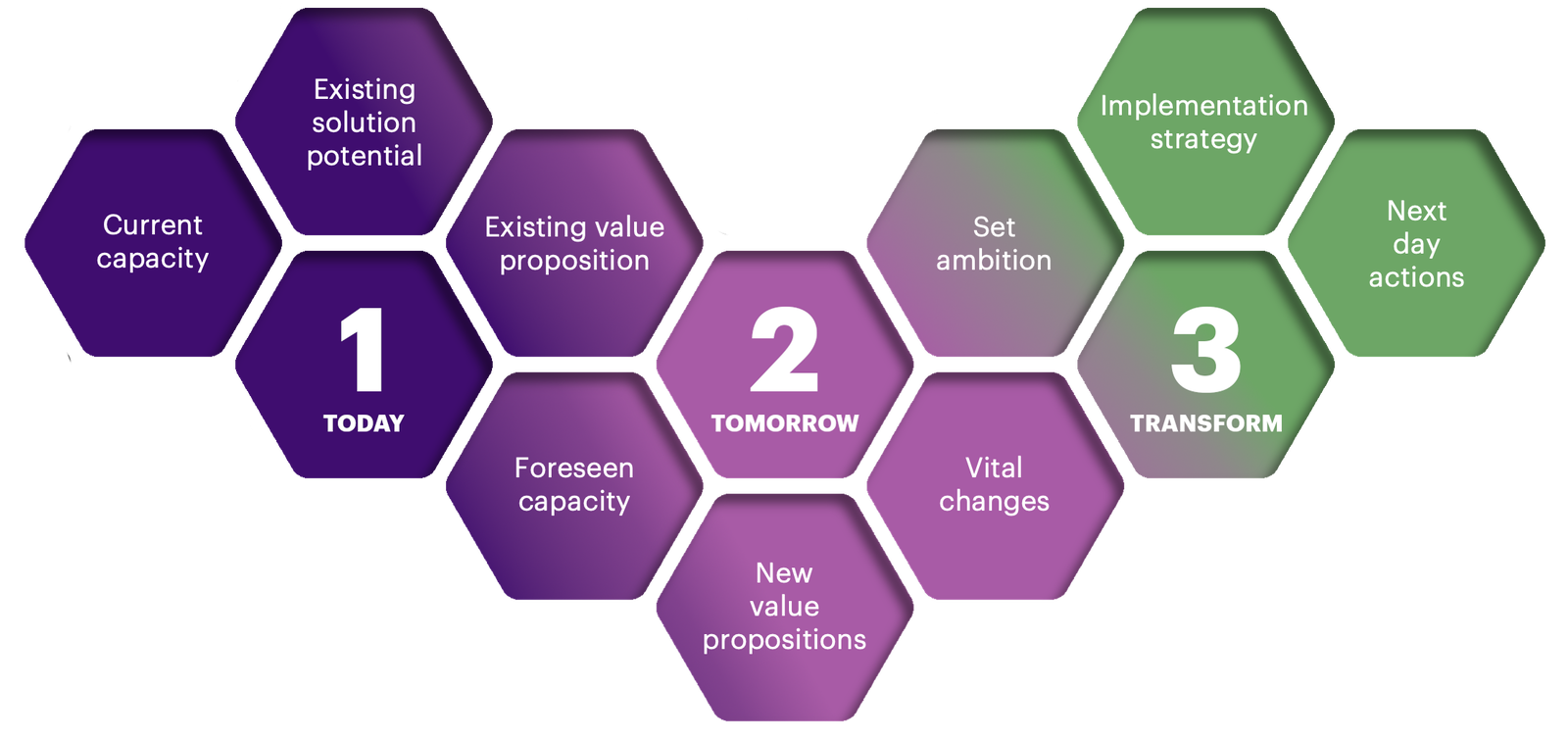
In the final step, assess these value propositions, set an ambition, and agree on the strategy for implementation and simple next-day actions.
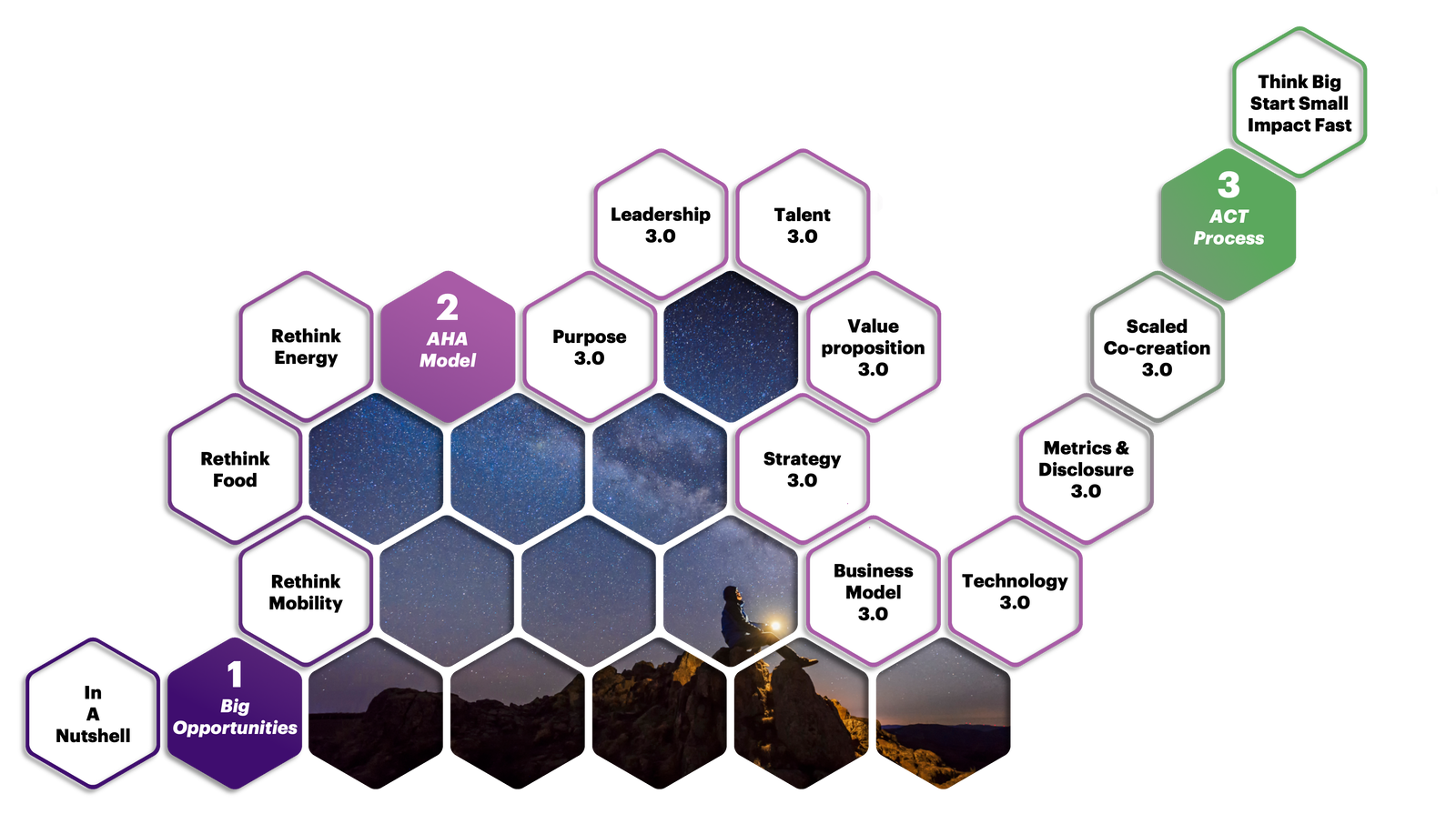

These opportunities demonstrate that sustainability coupled with technology is a major opportunity to integrate into a long-term strategy. And, as digitalization forced every company to become digital, now every company is forced to become a sustainability company. To turn these opportunities into tangible business results it is helpful for leaders to better understand where the world is headed.
Welcome to the age of instant access. Here we will access the things we need locally; energy (rooftop solar), food (3D printers), and mobility (Robotaxis). The American Dream is estimated to cost less than $250 a month by 2030, even less by 2035, and will include transport, nutrition, energy, water, education, and living space.
Mobility-as-a-Service
This connects electric vehicles with autonomous technology so we can access cars when needed and pay per mile or subscribe, resulting in the end of car ownership.
Cost per mile will be 4–10 times cheaper than buying a new car and avoided emissions of 90% by 2030.
The decrease in cost opens the way to free transportation — and trillions of dollars in business opportunities — where the low cost of transport (1–2 cents per mile) is covered by other revenue sources, such as entertainment, demand management, and data monetization.
Artificial food tech
This combines food-as-software with precision biology, where we will use molecular cookbooks, and where food designers create more nutritious, tastier, and cheaper foods; causing the end of animal agriculture.
Modern foods will cost 50–80% less, with net avoided emissions of 65% by 2035.
The disruption of food is inevitable and constant iterations will rapidly improve products and price, where this speed and scale of disruption in the modern food system will create opportunities in areas such as food distribution, biological technology, and software.
100% clean SWB
This creates energy systems of solar, wind, and battery (SWB), which by 2030 will offer the cheapest electricity; causing the end of coal, gas, and nuclear.
In 2030, SWB electricity will cost less than 3 cents per kilowatt-hour, avoiding all greenhouse gas emissions from the electricity sector.
As the Internet created trillions of dollars of new value by reducing the marginal cost of information to near zero, SWB will similarly reduce the marginal cost of energy to near zero, creating big business opportunities: road electrification, cryptocurrency mining, cloud computing, and more.
To enter this future, think in new ways.
You never change things by fighting the old ways of thinking. To change something, create new and more desirable ways of thinking that make the old ways of thinking irrelevant.
An industry leader 1.0 improves. An industry leader 2.0 innovates. An industry leader 3.0 impacts.

The model shows how a company evolves from left to right through its PEAs (Platforms, Enablers, and Accelerators):
Impact builds on innovation, which builds on improvement. No industry leader is completely in one maturity stage. The primary intention of each stage is to offer an indication of each company’s PEAs to better understand their complete picture.
Eating peas strengthens most immune systems. In this case, that of the company and planet. Great cash flow is the result of investing in high-quality PEAs. Let’s dive deeper by looking at them and we will start with the three platforms.
NEW WAY OF THINKING ABOUT PURPOSE: As an industry leader 3.0 we provide better value for all, recognizing that our positive impacts lead to better cash flow — acknowledged as ‘profit through purpose’.

87% OPPORTUNITY: Today, only 13 of 100 companies have embedded purpose into their strategy for sustainability. EQT Partners, for example, describes themselves as a purpose-driven global investment organization that will align all investment decisions in achieving the Global Goals.
NEW WAY OF THINKING ABOUT LEADERSHIP: As an industry leader 3.0 — instead of adapting to changes around us or even getting stuck in business as usual — we lead the change towards a better world.

LEAD WITH PURPOSE: Impacting the world has moved swiftly up the executive agenda in recent years. 99% of CEOs agree that sustainability is vital to the future success of their company.
NEW WAY OF THINKING ABOUT TALENT: As an industry leader 3.0 we enable an inclusive, equitable, and diverse workforce that exponentially benefits others and helps the world flourish.

BENEFIT OTHER AND YOURSELF: Purpose-driven organizations report 30% higher levels of innovation and 40% higher levels of workforce retention than their peers. Keep the employees happy and fully engaged.
With a solid platform in place, let’s have a look at the three enablers.
NEW WAY OF THINKING ABOUT VALUE PROPOSITION: As an industry leader 3.0 we provide the world with products and services that simply are better — simpler, cheaper, and more attractive — while net-positive.

79% of customers are changing their purchase preferences due to sustainability reasons. For this reason, what about leveraging sustainability as a driver for profit – and profit as a tool for sustainability?
A warm welcome to net-positive impact.
Net-positive impact
Sustainability has traditionally been about, at most, reaching net zero by reducing all the negative impacts of everyday operations. The holistic footprint. However, this is today too narrow of a vision. Go one step further by increasing the positive impacts. The holistic handprint.
Also, when the sum of all the impacts is net-positive you have a value proposition that gives back more to the world than it takes out from it – and still is the more profitable one.
This is the big shift. Here is where the industry leader 3.0 excels.
Houdini, for example, is working to minimize their negative footprint, move beyond zero, and leave an entirely positive impact on the world.
The focus shifts from company-first (inside-out) to world-first (outside-in).
Put a dent in the universe with a net-positive value proposition
88% of customers want companies to help them live sustainably and adopt a net-positive identity.
However, industry leaders 3.0 are not engaging customers on net-positive explicitly but instead play up the benefits of a better product. They nudge customers to make net-positive choices; because they want it and as it is better for them – and the world.
NEW WAY OF THINKING ABOUT STRATEGY: As an industry leader 3.0 we let the global goals and net-positive impact guide our global, long-term, and solution-driven strategy.

Heartprint
Strategy 3.0 imprints the global goals and net-positive impact at its heart. Here they are integrated into everything the company does and viewed as a strategic advantage rather than a cost. This heartprint will shift the strategy in three major ways.
Shift one: global garden
If you haven’t already, go beyond your local backyard. Make the world your garden. National economies are more tightly connected than ever due to globalization. You're part of the global economy. Admit it in your strategy.
Shift two: 20-year vision
Many investors will look for liquidity and short-term gains until companies start providing financial results from their net-positive efforts. But that does not stop you from reimagining what business you are in the long term.
Breakthrough Energy Ventures, for example, has a 20-year time horizon. It is backed by notable partners such as Bill Gates, Abigail Johnson, Jack Ma, and Jeff Bezos. About 90% of their portfolio consists of ventures geared toward the Global Goals. So far, they have raised more than $2 billion.
With longer investment horizons your business opportunities will be put in a broader perspective and make room for the third shift.
Shift three: holistic net-positive strategy
To go beyond a net-zero strategy, Paul Polman and Andrew Winston, in their book Net Positive, look at a net-positive strategy for people, the planet, and profit.
They mention six scopes (three footprint scopes and three handprint scopes) that each has the potential to exponentially scale impact.
Footprint: scopes 1-3

These scopes look at the problems you can reduce and roughly control.
Scope 1: Reduce direct emissions from own operations; company cars, and more. Secure employee safety.
Scope 2: Reduce indirect emissions related to purchasing heat, steam, electricity, and cooling. Increase employee well-being.
Scope 3: Reduce indirect emissions from supply-chain and value-chain, such as product usage. Increase supplier and customer well-being.
This is vital as it eases the foot from your strategy break. But if you get stuck here, you’ll at best reach net zero and end up with a risk-driven strategy focused on cost reductions.
Handprint: scopes 4-6
These scopes look at the solutions you can provide and roughly influence.
Scope 4: Provide solutions to avoid communal and sector emissions. Increase community well-being.
Scope 5: Provide solutions to avoid global emissions. Influence policy and influence the systems of well-being, such as healthcare and food.
Scope 6: Provide solutions to rethink a societal consumption-based culture and energy-intensive lifestyles. Influence the well-being of the natural world and enable flourishing lifestyles.
With the foot off the break, you can now put the pedal to the metal to accelerate your innovation-driven strategy for green revenues.
A big scope of net-positive
Industry Leaders 3.0 embrace the full scope (1-6). This is their holistic net-positive strategy; to maximize their value proposition of giving back more to the world than they take out.
IKEA, for example, has a People and Planet Positive strategy to achieve the big positive changes they want to see in the world and the IKEA ecosystem.
The scope of your impact will be the major differentiator for deciding the scope of your shareholder returns. When you give more, you get more.
To start the transition several companies are, for example, applying an internal carbon tax and using those funds to invest in net-positive efforts.
From strategy to innovation
Strategic power starts with innovation and ends with market size. Having landed in a global, long-term, and holistic net-positive strategy, it is time to create a solution-driven portfolio through business model innovation.
NEW WAY OF THINKING ABOUT BUSINESS MODEL: As an Industry Leader 3.0 we look far beyond existing systems and solutions when we address customer core needs by dematerialization and regeneration.

From global goals…
Peter Drucker said that every single social and global issue of our day is a business opportunity in disguise. Companies that leverage the Global Goals as drivers of innovation will be the biggest players on the green $12 trillion playing field. The ticket to enter that field is embracing customer needs through the Global Goals lens.
…to customer needs
Business model innovation starts from customer needs. There is no larger risk to companies than going against the needs, wants, and desires of their customers. Those who lose customers do it because they lose their focus on the customer by focusing too much on protecting their core business.
See your company through the customers' eyes. Obsess over them.
But where do we start to think like a net-positive customer in the 21st century? Their core needs.
Core needs
Since the 1970s thinking outside the box has been accepted as thinking creatively. But why is this not enough today? Because, even if we escape the mind prison of the box, we are still trapped by the idea of its existence.
People are framed in their way of thinking and when faced with complex problems default to think like everyone else. What is an office to you? A physical company space? A physical space at home? Or even a virtual space (laptop anywhere)?
Exercise: expand your thinking
The goal of this exercise will be for our three Industry Leaders to avoid as much greenhouse gas emissions from combustion cars as possible.
Industry leader 1.0
This leader uses inside-the-box thinking; narrowly thinking of cars plus emissions, asking: How might we optimize the car? The result is a more fuel-efficient combustion car.
Industry leader 2.0
This leader uses outside-the-box thinking and expands the innovation space by asking: How might we rethink a car and its environment?
The result is an electrical car powered by batteries, charged with wind and solar. They might also rethink the surrounding ecosystem, by pushing for government action to reengineer roads to reduce the need for batteries and let the cars draw energy from the ground by induced electricity. Further, they might provide Mobility-as-a-Service offerings, such as Robotaxis, to satisfy the need for mobility.
Industry leader 3.0
This leader uses no-box thinking by removing the car from the equation by asking: How might we satisfy the core needs of people to move around?
The results are compact, complete, and connected cities, to reduce the need for cars. They also offer e-health, e-banking, online education, and virtual entertainment, to reduce the need for mobility and satisfy the core need of accessing value – such as:
Thinking will take you from A to B, but imagination will take you anywhere.
Enter the matrix
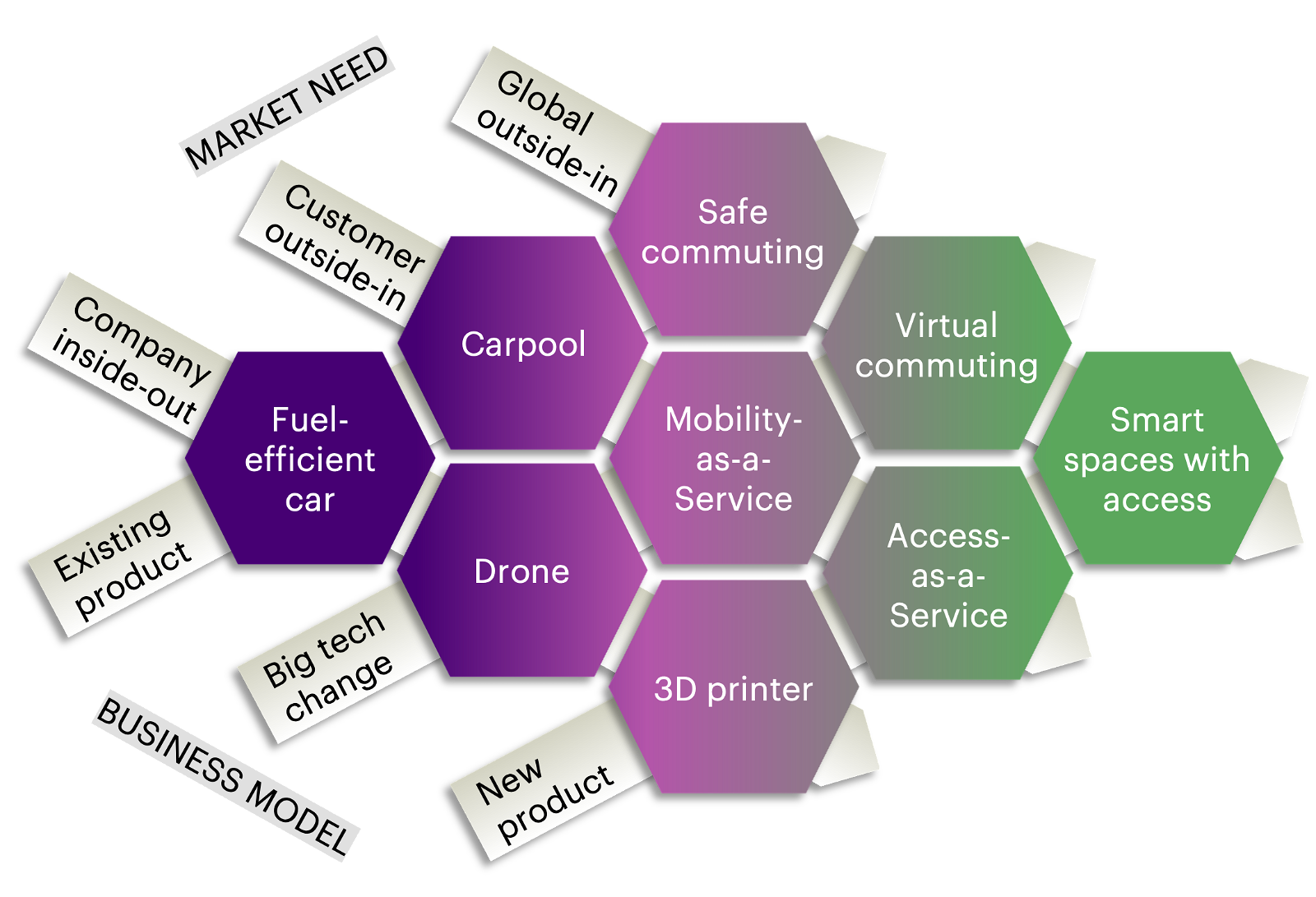
In the exercise, you probably noted a big shift: going from small incremental steps to giant exponential leaps.
This way of seeing beyond existing products to include core needs and a systems view brings us to the impact innovation matrix; to help find the right solutions.
How to use the matrix
Here we are exploring how to rethink a car from left to right, where the matrix explores different solutions through the eyes of market need, business models, and innovation space. The further to the right, the more the innovation space – and the more the impact. And vice versa. The matrix helps you explore nine solutions at the intersections of market needs and business models.
Business models
New technologies tend to grab the headlines, but it is business model innovation that underpins the most successful examples of exponential solutions, as stated by Thales Teixeira in his book Unlocking the Customer Value Chain. Let’s explore the essence of net-positive business models.
Dematerialization and regeneration
Dematerialization is about reducing resources needed from nature to provide value. Reducing the footprint.
Regeneration aims to provide value while restoring the environment to its former state. Increasing the handprint.
In essence, industry leaders 3.0 aim to achieve more with less through innovation by going circular, going servification, and going digital.
Circularity is about gradually decoupling economic activity and value creation from the use of finite natural resources until full circularity is achieved; where resources, materials, products, and services circulate indefinitely in a continuous loop. It shifts from an extractive approach (take-make-waste) to a regenerative way (take-make-regenerate).
Here, instead of customers paying big upfront costs to own a product, they rent, lease, or subscribe to its value. This is built on the idea that customers don’t desire the product itself, but access to the value and expected outcomes it offers. Customers go from ownership to users, using the product-as-a-service.
Since customers benefit from not having to invest in a product, it makes the product more affordable and its value more accessible, thus increasing your customer base. With more customers and fewer products to support, you can instead invest in and charge for more high-quality services.
Increase revenues further by offering life-cycle services that maintain, repair, and upgrade the product.
Transforming products or services into digital variants offers benefits over physical products, such as simpler and faster distribution, and a powerful way to dematerialize physical resources.
Provide access to better value
Today, we are moving from a society defined by scarcity and the need for more to a society where quality matters and companies are rethinking their role accordingly. Instead of thinking that they are in the business to sell more products, they think of ways to provide access to better value.
Next, let’s explore the three accelerators.
NEW WAY OF THINKING ABOUT TECHNOLOGY: As an Industry Leader 3.0 we recognize technology as a powerful tool, which we leverage to accelerate our net-positive business model for better impact and value.

Tool for better acceleration
Technology is one of the great drivers of human development and can fundamentally change everything. With it we are granted space to innovate on whole new levels.
But, in all this it is important to recognize one thing: technology is just a tool. It can accelerate sustainable business models – as well as unsustainable ones. The question is: How do we want the world to look like – and how might we leverage technology to accelerate that future?
This is making the technology itself sustainable through green software solutions and by eliminating the side-effects of technology, such as data pollution, cyberbullying, and built-in bias or discrimination in the use of artificial intelligence.
Here technology is leveraged to accelerate net-positive impact, such as boosting your business model and building trustworthy ecosystems where privacy, transparency, and fairness are valued.
Today, Information Communication Technology (ICT) accounts for 4% of the global footprint. However, this sector simultaneously has the potential to positively impact all other sectors with its 96% footprint; a 96% handprint opportunity window.
HP (Hewlett Packard), for example, is a technology company born of the belief that companies should do more than just make a profit. They should make the world a better place.
The most important contribution we can make is to use technology as a tool to better impact the planet and people.
NEW WAY OF THINKING ABOUT METRICS AND DISCLOSURE: As an Industry Leader 3.0 we recognize disclosure as a brand builder and profit as the effect of the better value we provide people and planet.

The transparency advantage
The idea of only considering financial (quantitative) metrics is outdated. Non-financial (qualitative) indicators are now expected to be aligned with financial strategy and sit alongside financial indicators in annual reports.
For Industry Leaders 3.0 credibility is key. Measuring and analyzing their negative impacts to reach net zero and producing annual impact reports is seen as a hygiene factor. The differentiation exists in transparency about their non-financial metrics and net-positive ambitions and progress.
Microsoft, for example, is measuring and disclosing its net-positive efforts for 2030; carbon negative, zero waste, and water positive.
Transparency no longer is an option and honest, transparent, and ethical communications resonate best with people. Companies that are trusted by customers also see annual growth rates of over 10% on their top and bottom lines. Not only that, but as Yvon Chouinard and Vincent Stanley note from their time at Patagonia in their book The Responsible Company, is that in a downturn people do business with fewer companies – and they do it with those they respect and trust most.
It is not only customers. More than ever investors are demanding transparent, traceable, and quality sustainability data from companies. Larry Fink, CEO of the world's largest asset manager Blackrock, in his 2020 letter to CEOs, called sustainability their new standard for investing.
This calls for open, clear, and measurable metrics that align the company and its stakeholders.
Being a solution provider
Most frameworks or methodologies for measuring today use an accounting approach that allows organizations to track their own emissions (scope 1-3), without understanding how their products and services lead to avoided emissions in society (scope 4-6).
This incentivizes leaders to focus on cost and risk reductions; holding back the development of innovative solutions that have a far greater impact on avoiding emissions across the planet for net-positive impact.
What is vital then is to not only be a problem mitigator but, more than anything, a solution provider that measures product opportunities for $12 trillion in green revenues.
Don’t worry, be happy
What is measured matters – but differs between the companies’ contexts and ambitions. However, some similarities are universal, and it all ends up in:
Happy Customers x Happy Employees x Happy World = Happy Finances
Happy customers
Here, measure market share, customer satisfaction, customer lifetime value, referrals, and investor parameters.
Happy employees
To provide value in a qualitative, compliant, and speedy fashion, the company will want to measure Lean metrics (such as flow-efficiency and lead-time), employee satisfaction and net-positive capability as well as the increase in innovation and learning. Without that backbone, the company's skeleton will crumble.
Happy world
Look at the full range of impacts through scopes 1-6, the 17 global goals, and their 169 targets.
Science-based targets
Science-based targets are crucial. Aligned to planetary boundaries they provide a clear evidence-based path for companies to reduce emissions and future-proof business growth.
Creating policy and business metrics aligned with science, such as 1.5°C compatible solutions, is something sustainability investors want to align with to enable the greatest impact.
Impact as brand
Leaders can shape their narrative with a clear articulation about the potential for the long-term value of a net-positive business to get stakeholders on board. But in the end, it will boil down to disclosure and outcomes. For this reason, let your actual impact tell your story and be your brand. Imagine what will happen the day when the world starts valuing your impacts more than your ambitions and actions. That day is soon upon us. Better start now.
Trust is about people. The AHA model started with people and will now finish with people co-creating impact.
NEW WAY OF THINKING ABOUT SCALED CO-CREATION: As an Industry Leader 3.0 we are scaling co-creation from team level to ecosystem level to be able to deliver the solutions the world needs and happily pay for.

Net-positive by design
80% of a product’s environmental impact is determined in the design stage. Coupled with the fact that poor quality and rework are sinkholes for profit, innovating a net-positive product is all about designing for quality over quantity, product excellence over timeline, and value over price. This co-creation is about collaborative innovation; namely Agile.
Scaled agility
Agile started out as a way for teams to create better software in less time. But as many companies felt the pressure to be more adaptive to their changing circumstances, scaled agility, with a high focus on leadership, has in many ways become synonymous with change management and helping cultures evolve and better align with purpose, strategy, and culture.
This is where scaling agile from the team level to the organizational level makes a huge difference.
And, to understand why we want to scale co-creation to yet another level, let’s look at wicked problems.
Wicked problems
Wicked problems represent some of the most complex problems of our time, and the Global Goals represent the global needs of those problems.
Data, innovation, and technology are crucial for breaking the barriers and solving these complex problems. However, no single organization can hope to solve them alone.
To turn wicked problems into business opportunities – and find successful solutions – then expand, engage, and transform your business ecosystem.
Build a co-creative ecosystem of trusted partnerships
What your interconnected network of courageous collectives looks like is a unique orchestration and depends on your context and ambition.
Except for your board, employees, and shareholders, there are five levels of groups to consider:
The important thing here is the diversity of thought and capabilities to help see beyond assumptions of how to solve wicked problems and leverage the cumulative strengths of the ecosystem to unlock value and revenues at scale.
Risk-sharing mechanism
In addition to the big opportunities presented by ecosystems, they form a risk-sharing mechanism; better allocating risks and cutting costs.
They can also overcome technical, economic, or other structural barriers that come with long-term technology development via pooling resources and investment.
7 ecosystem accelerators

Solutions to global needs will be global too
From now on, driving systemic change on a global scale and developing radical net-positive ways of doing business in line with the global goals through ecosystem clusters will be essential and differentiating skills for a world-class industry leader. The scene is set. Co-create net-positive impact at scale, share the risks and seize the $12 trillion revenue opportunity.
You’re now ready for the final step; to put the AHA model into practice.
Sustainability is simpler if you know what you are doing. To bring clarity to our thinking and help us start small at low cost, it is time to shift from awareness (AHA model) to action by leveraging A Catalyzing Tool (ACT) to drive profit from global solutions.
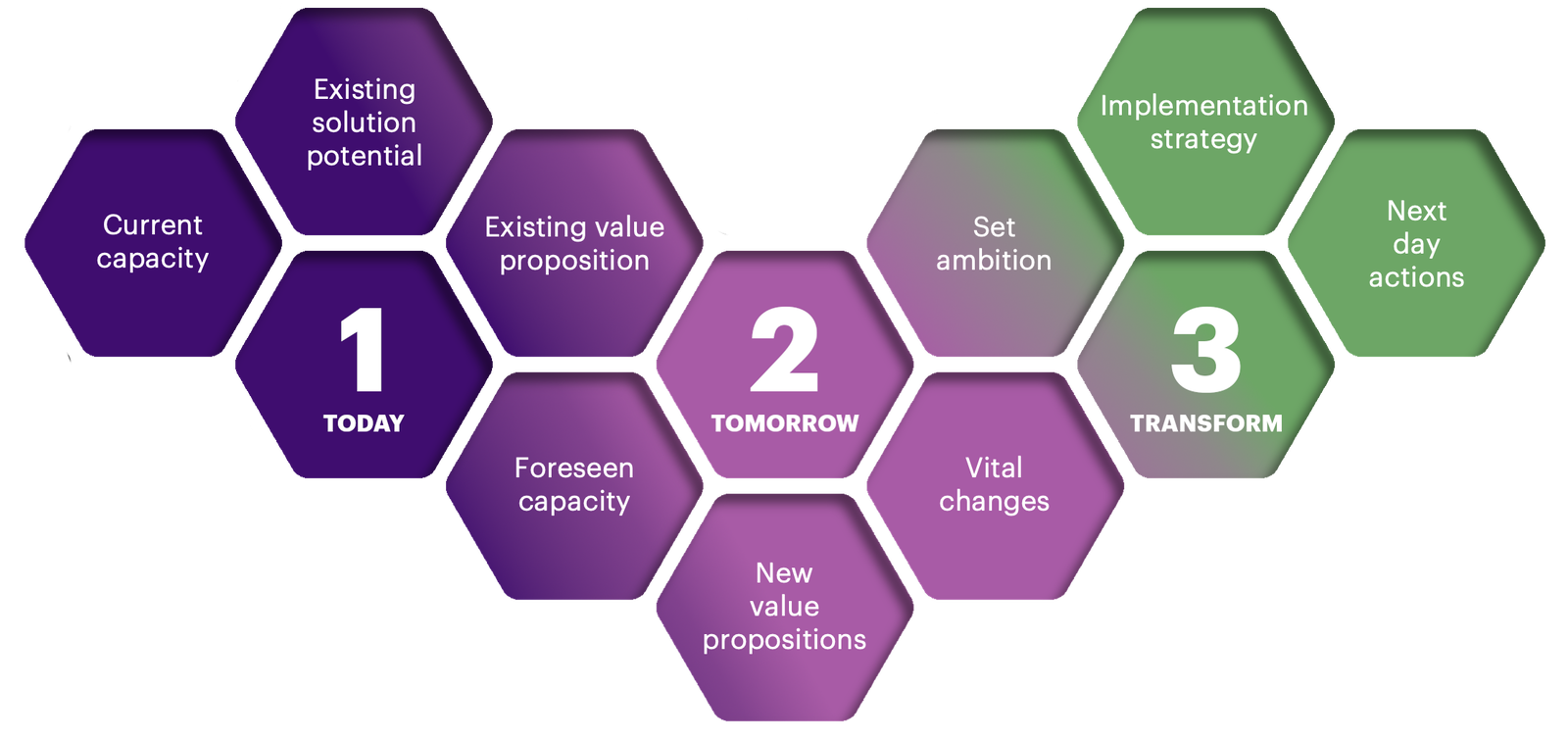
How does it work?
Through three steps this process will leverage the basics of the AHA model and add some extra layers:
Unlike many other processes, the ACT process has a strong focus on the implementation strategy and provides support in taking the first small steps.
During the first step, leverage a systematic and tailored maturity and capacity assessment, through the lens of the AHA model, to provide an overview of your current situation and context, and the potential as a company to go beyond where we are today to seize $12 trillion opportunities by delivering global sustainability solutions and net-positive impact.
1.1 Current capacity
Identify a high-level score of the capacity the company has based on this grading scale:
Industry leader 1.0: 0-1
Industry leader 1.5: 2-3
Industry leader 2.0: 4-6
Industry leader 2.5: 7-8
Industry leader 3.0: 9-10
Additionally, rank each of the nine PEAs (Platforms, Enablers, and Accelerators) from zero (0) to ten (10) to clearly state to which degree each of them supports global sustainability and net-positive impact. Clarify what is currently done well, what is lacking, and recommendations moving forward.
1.2 Potential of existing offers
Perform a benchmark of currently provided products and services, and how they relate to global needs and customer needs.
1.3 Existing value proposition
Assess strengths between a company’s existing value proposition, strategy, leadership, and global goals, through the impact-innovation lenses.
Impact-innovation lenses
Here, leverage an outside-in approach to apply the three impact-innovation lenses. From a scale of 0 (zero) to 10 (ten), find out how well the existing value proposition and business model perform:
Planet
People
Profit
With a good grasp of where the business is, look at where it wants to be.
This step explores the company´s opportunities to develop sustainable and net-positive solutions aligned with $12 trillion green revenue streams.
2.1 Global trend scanning…
What global trends are relevant for the company to become net-positive:
…AND FORESEEN CAPACITY
This capacity looks at the contexts where future solutions are developed. This covers a similar assessment as for the current context (1.1). But, instead of considering the current situation, here the capacity is reviewed based on expected changes.
2.2 Potential value proposition
Based on the global trend scanning and foreseen capacity, bring forth nine value propositions for moving the company from the present situation to one in which the company provides sustainable and net-positive solutions.
Present these value propositions through the impact innovation matrix, but with an expanded scope: beyond the existing geographical limit and time horizon, beyond existing business models and technologies, and beyond existing or perceived competitors and partners.
Let these value propositions be seen in relation to any company with the capacity to deliver on their potential value propositions.
2.3 Vital changes
The last assessment is about understanding what the vital changes to be implemented are, to be able to provide these value propositions.
For any company it is important to understand where they are, to set the right ambition level. Every journey will be different. Be realistic, but optimistic.

Does the company have the need, capacity, and ambition to:
1.0: Manage risks, costs, and compliance requirements?
Includes hygiene factors: short-term investor concerns, community expectations, and branding mitigation; otherwise just continue with business-as-usual.
1.5: Start exploring sustainability to boost profits?
Includes scope 1: Secure employee safety, reduce direct emissions from operations, and differentiate from competitors by offering greener products and services.
2.0: Meet net-zero targets by embracing circularity?
Includes scope 1–3: Increase employee, supplier, and customer well-being, and reduce indirect emissions; focus on dematerialization and servification.
2.5: Set yourself apart as a sustainability company?
Includes scope 1–4: Increase community well-being and provide solutions to avoid communal and sector emissions with a focus on handprint and regeneration.
3.0: Reimagine your portfolio for net-positive impact?
Includes scope 1–6; global emission solutions, influence policy and the systems of well-being, and provide solutions to flourishing lifestyles through partnerships.
3.1 Prioritize value propositions
To enable a net-positive tomorrow, identify possible routes to solutions by prioritizing the potential value propositions.
It is advised to explore at least three value propositions and the emphasis is on the best route from the current situation — in terms of need, capacity, ambition, leverage, cost of delay, and effort — rather than the exact optimal position in the future.
The focus is on that which delivers both impact and business value; answering: How might the business accelerate its profits by building a better world?
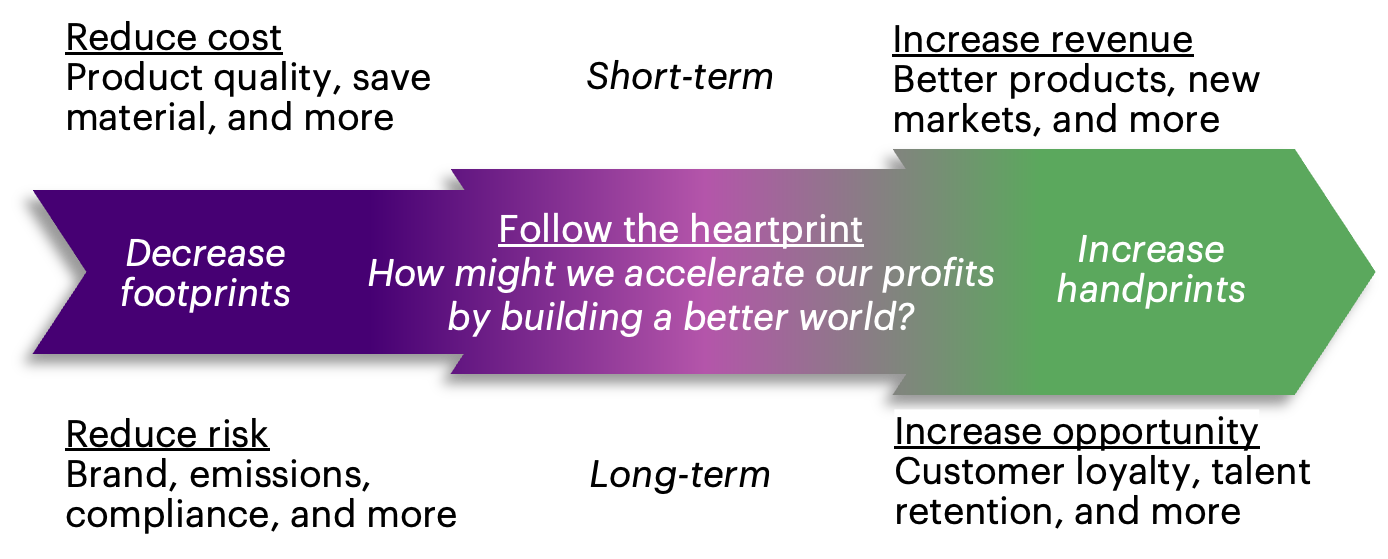
Explore:
Initially, only a few people tend to be enough to continuously explore opportunities, emerging trends, market changes, and for the transformation work to make progress.
3.2 Implementation strategy
Identify the transdisciplinary teams of key stakeholders essential for implementation. Many find it helpful here to get inspired by the sustainability goals of the world’s largest and leading companies to understand how they define success. Produce the strategic launch of the new offering.
3.3 Next day actions
Finally, to ensure that the investments and ambitions go beyond becoming a paper product, create a list of Next Day Actions.
You'll know you're on the right track when you say: Why didn't we do this sooner?
Future Thought Leaders is a democratic space presenting the thoughts and opinions of rising Sustainability & Energy writers, their opinions do not necessarily represent those of illuminem.
John Leo Algo

Ethical Governance · Environmental Sustainability
illuminem

Consumers Green Tech · Corporate Social Responsibility
Charlene Norman

Sustainable Business · Sustainable Finance
The Verge

Diversity & Inclusion · Corporate Social Responsibility
The Wall Street Journal

Sustainable Lifestyle · Corporate Social Responsibility
illuminem Voices

Ethical Governance · Climate Change